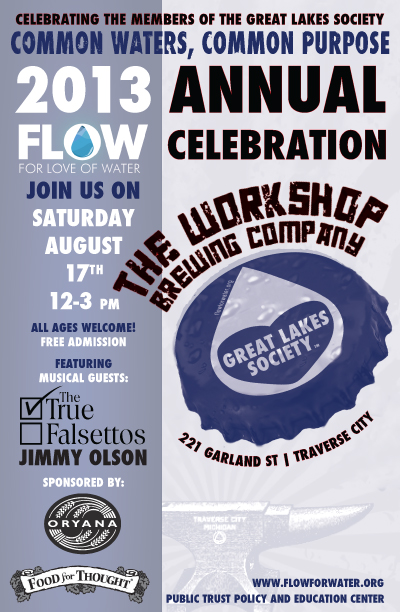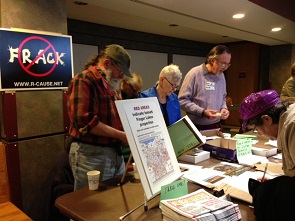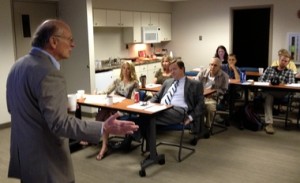
The child who grew up in the natural wonderland of the Traverse City region is now the sage of the environmental community in Michigan. On Wednesday, February 26, FLOW founder Jim Olson, whose legal work transformed both the law and the landscape, turns 80.
It’s a milestone that gives Jim the opportunity to look back, but his thoughts are also on the future. What kind of a world are we leaving to our descendants? What gives us hope?
But let’s start at the beginning. In Jim’s early youth, his father, who had grown up in Boyne City, grew homesick for the north and moved the family from Detroit to the Traverse City area. Jim is grateful for that good luck, as the location shaped his childhood and world view.
“We grew up with hills and woods on one side, and the open waters of the east arm of Grand Traverse Bay on the other,” he says. “And so our childhood play every day, every season, was outside.”
Despite his love for the outdoors, the idea of devoting himself to environmental law did not occur to him upon his graduation from Detroit College of Law. As he points out, there was no real environmental law practice in Michigan, as modern pollution and land use laws were just beginning to take shape.
 But while clerking in Lansing for Michigan State Supreme Court Justice Thomas Brennan in 1971, Jim saw a poster for a presentation by the author of the 1970 Michigan Environmental Protection Act (MEPA), Joe Sax, and decided to attend. As he puts it, “a light bulb switched on.”
But while clerking in Lansing for Michigan State Supreme Court Justice Thomas Brennan in 1971, Jim saw a poster for a presentation by the author of the 1970 Michigan Environmental Protection Act (MEPA), Joe Sax, and decided to attend. As he puts it, “a light bulb switched on.”
Jim was “astounded” by the Sax lecture. In it, the University of Michigan law professor explained that the law was designed to enable citizens to protect the environment through the courts. “He created a law that charged the court to recognize claims by citizens to protect the air, water and other natural resources and the public trust in those resources from pollution, impairment and destruction. And you didn’t have to wait for the damage to actually occur. If it was probable, or there was sufficient endangerment, people could bring actions to prevent the harm.”
Jim adds, “It was not like anything I had heard in law school a year earlier. I went away from that meeting so interested – I thought, this is what I want to do. I want to learn everything I can about this.”
And he did. By 1973, Jim and his family moved to Traverse City, where he opened a law practice with his friend Michael Dettmer. Through a stroke of fortune, one of the first major MEPA cases found Jim.
A group of citizens wanted to challenge the proposed construction of an addition to the Holiday Inn at the mouth of the Boardman River on the west arm of Grand Traverse Bay that they said would take from the public waterfront land that the government was obligated to protect. The sale of the land by the Michigan Department of Transportation to the owner of the Holiday Inn violated the state’s obligation to protect the public interest in the shoreline. Jim handled the case for the citizens.
The lawsuit resulted in a landmark recognition by the trial court that MEPA and the public trust doctrine applied to the claim at hand. Although the trial court ultimately ruled against the citizens group, the leverage of the lawsuit helped persuade the hotel’s ownership to reshape the design of the addition so that only half as much of the waterfront was affected.
That case was the prelude to a much bigger controversy over a proposal by Cleveland Cliffs Corporation to build a coal dock on the northern reach of the City of Marquette’s Lake Superior shoreline. The state Department of Natural Resources had leased the lakebed to permit the development to go forward. Julia Tibbits, whom Jim remembers fondly for her wisdom and commitment to principle, led a citizen fight to stop the coal dock. She, Jim and their supporters took on powerful political, corporate and community interests, a story recounted in a book by Tibbits, Let’s Go Around the Island.
After a heated battle, the action against Cleveland Cliffs successfully limited harm from the coal dock while providing public benefits. Cleveland Cliffs agreed to cover the coal to prevent coal dust from entering the lake or leaching after precipitation; turned over the shoreline both on both sides of the dock to the city for public use; and established a fund to pay for the removal of old coal unloading structures close to the downtown lakefront. Today, the Marquette waterfront is considered a jewel.
Jim says the case illustrates an often overlooked impact of the 1970 MEPA. “If MEPA is actually implemented by the courts as written, it will do what it is supposed to do,” he says. “Even if you don’t win, if it’s a substantial case, not just based on emotion, and reasonably based on fact, it opens the door to a situation where people are empowered to play a meaningful role in agencies or in the courts. Because of this framework, not every suit has to go to trial. Because rather than fight, the defendants often look for ways that achieve a better result.”
Not long after the Cleveland Cliffs case came along, organic farmers hired Jim and a colleague, Bill Rastetter, to block the proposed spraying of a toxic chemical on 100,000 acres of farmland across six counties in central lower Michigan, to control a gypsy moth infestation. Such a pesticide application risked contaminating organic farm produce, making it unsalable. In addition, Jim and his clients identified a prudent and feasible alternative to the spraying – biological controls – and MEPA says if there is an alternative to an action that might compromise the environment, it should be pursued.
Jim’s arguments in the case resulted in total victory for his clients. The trial judge issued a scathing ruling, barring the spraying and ordering the state to round up the chemical and get it out of the state.
This MEPA and public trust law work in the early 1970s led to a fellowship at the University of Michigan Law School, where he studied under Joe Sax, the professor that inspired him to pursue environmental studies in 1971. At U of M, Jim obtained a Masters of Law Degree in 1977. As further cases proceeded in the 1970s and 1980s, Jim helped build a nationally significant body of law.
Another major victory came in 2003, when Jim won a trial court ruling, affirmed on appeal, limiting the volume of water that the Nestle Corporation could remove from groundwater near Evart as part of a water bottling operation. As a result, the levels of lakes, streams and wetlands in the vicinity have been maintained and ecological integrity protected. Jim’s work on this case and related issues, and public interest in protecting the waters of the Great Lakes region from private exploitation and diversions, led to the formation of FLOW in 2011.
Jim credits the citizens whose cases he litigated for having the courage to take public stands and persist. He names dozens of such people, from Julia Tibbits in the Cleveland Cliffs case to Terry and Gary Swier in the Nestle case.
 Turning 80 is a good time for reflecting on life’s lessons, and Jim did that in a book published in 2024, People of the Dune. The book, which dramatizes the inability of the law to fully recognize the non-material value of sacred lands, has received high ratings and a warm response.
Turning 80 is a good time for reflecting on life’s lessons, and Jim did that in a book published in 2024, People of the Dune. The book, which dramatizes the inability of the law to fully recognize the non-material value of sacred lands, has received high ratings and a warm response.
Jim recently said, “Just the other day a reader from a book club in the U.P. said they had read the book and it generated a real discussion. That means a lot. It’s the people reading People of the Dune who get something out of it that is the most satisfying thing about the book.”
After more than 50 years of practicing law, Jim remains cautiously optimistic about the future of the environment as citizens become more aware of the reality that every aspect of their lives and community depend on clean water, air, and the environment.
“If we don’t have a cultural transformation that transcends the current political division in our country that recognizes the importance of nature to our lives – if we don’t begin to make this connection or relationship – then I’m not optimistic at all,” he says.
In the future, many more people will become aware of Jim’s legacy. On Sunday, July 31, 2022, Jim’s colleagues, friends, and family celebrated the dedication of a marker honoring Jim at the Old Mission Lighthouse Park north of Traverse City.
The plaque, bearing the image of a lighthouse and a deep blue background, reads:

James M. Olson
Keeper of the Great Lakes
Just as lighthouse keepers once kept watch over these waters, Jim Olson began watching over the Great Lakes in the early 1970s. As an attorney, advocate, and author, Jim pioneered the use of the Michigan Environmental Protection Act and the Public Trust Doctrine to guard the state’s shorelines and water resources for public use and enjoyment. Your public water rights—for drinking, fishing, swimming, boating, and shoreline walks—are upheld by Jim’s lasting legacy.

 With a formal launch 7 p.m. June 26th at
With a formal launch 7 p.m. June 26th at 










